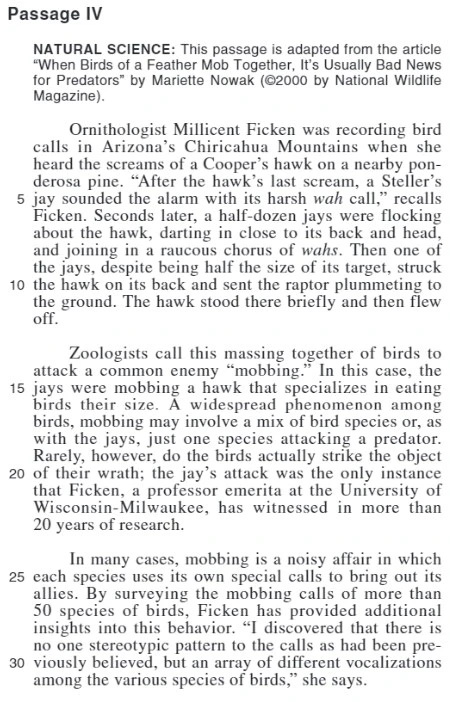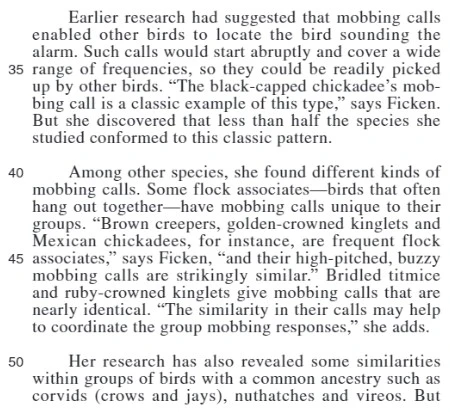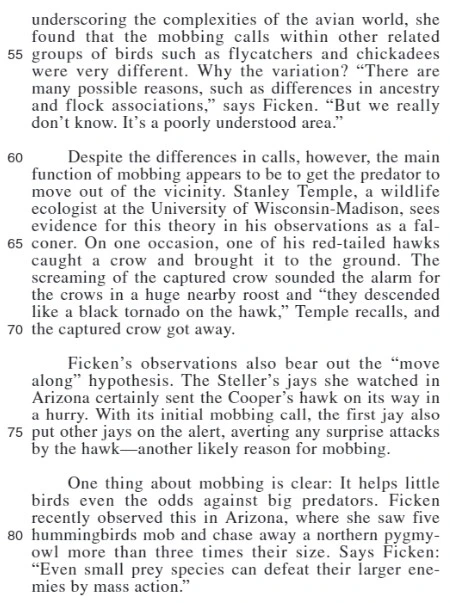Section: Reading 0 Likes
Passage IV - Ornithologist Millicent Ficken was recording bird calls (September 2023 - G01)



Questions from Passage IV
31) Which of the following statements is NOT supportedby the passage?
A. Brown creepers, nuthatches, and Steller’s jaysshare a common ancestry.
B. Ficken has been witnessing mobbing incidents forat least 20 years.
C. Temple has made observations that support the“move along hypothesis.”
D. Ficken’s research disproves an earlier belief that mobbing calls conformed to one stereotypic pattern.
32) It can reasonably be inferred from the passage that theaverage life span of members of a small-bird species is increased by the birds’ ability to:
F. travel with large predators.
G. eat birds their own size.
H. avoid contact with flock associates.
J. participate in mass action.
33) What is the function of the first two paragraphs (lines1−23) in relation to the passage as a whole?
A. To introduce the idea that Cooper’s hawks special-ize in eating Steller’s jays and are the most commonpredators in mobbing incidents
B. To identify Ficken as the leading authority on mob-bing and highlight her credentials and background
C. To provide a definition of mobbing and illustratean unusual example of it
D. To present the opposing points of view held byornithologists and zoologists on a widespread phe-nomenon among birds
34) According to the passage, the Steller’s jay’s initialmobbing call resulted in all of the following EXCEPTthat it:
F. signaled other jays to flock around the predator.
G. put other jays on the alert.
H. motivated the Cooper’s hawk’s raucous chorus ofscreams.
J. prevented surprise attacks by the predator.
35) When Temple compares the flock of crows mobbingthe red-tailed hawk to a “black tornado” (line 69), he illustrates a point made earlier in the passage that:
A. crows are the birds most commonly associatedwith violent mobbing attacks.
B. some birds have the ability to aggressively attack apredator.
C. mobbing typically involves a mix of aggressivebird species.
D. crows often physically strike the object of theirwrath.
36) According to the passage, Ficken concludes that the“classic” mobbing call is used by:
F. most of the mobbing species she studied.
G. fewer than half of the species she studied.
H. birds she studied in Arizona but not other places.
J. birds that often hang out together.
37) Which of the following statements best expresses themain idea of the sixth paragraph (lines 50−59)?
A. Ficken finds it difficult to explain the variation inmobbing calls within certain related groups of birds and feels there is still a lot to be learned.
B. Flycatchers and chickadees have similar mobbingcalls to those of crows and jays because they are connected by common ancestry.
C. Differences in ancestry and flock associates arethe primary reasons for the variation in the mob-bing calls of certain related groups of birds.
D. Similarities of mobbing calls within certain relatedgroups of birds underscore the complexities of the avian world.
38) As it is used in line 5, the phrase “harsh wah” mostnearly refers to the:
F. last scream of the Cooper’s hawk.
G. combined screams of the Cooper’s hawk and Steller’s jay.
H. alarm call of the first Steller’s jay.
J. Steller’s jay’s imitation of a human scream.
39) As it is used in line 24, the word affair most nearlymeans:
A. occasion.
B. observation.
C. catastrophe.
D. accident.
40) According to the passage, which of the following pairsof bird species has similar mobbing responses because of common ancestry?
F. Hawks and jays
G. Chickadees and crows
H. Hawks and kinglets
J. Crows and jays
Solution
Correct answer:
31 - A
32 - J
33 - C
34 - H
35 - B
36 - G
37 - A
38 - H
39 - A
40 - J
Exam Edition: September 2023 - G01
Exam Year: 2023
Related topics: Textual Comprehension, Interpretation and Reading of Text